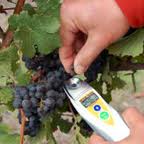 With
September comes harvest time in the vineyard. From now through October, most of the grapes will be picked
and crushed, juice will be put into tanks and barrels, and wine making will
begin.
With
September comes harvest time in the vineyard. From now through October, most of the grapes will be picked
and crushed, juice will be put into tanks and barrels, and wine making will
begin.
The actual timing of the harvest varies, year to year, depending on what types of grapes are being picked and when they have reached their peak ripeness. There are several factors that come into play when deciding when to pick; including the varietal, the acid, tannin and sugar levels of the grapes, what style of wine the winemaker will be making, and the weather.
 Even
the actual method of harvesting can cause serious discussions in wine
circles. Most vineyards that mass
produce wine prefer to use machines to harvest the grapes, while smaller
vineyards, and those with a more traditional approach, prefer handpicking.
Even
the actual method of harvesting can cause serious discussions in wine
circles. Most vineyards that mass
produce wine prefer to use machines to harvest the grapes, while smaller
vineyards, and those with a more traditional approach, prefer handpicking.
Mechanical
harvesting caught on in the U.S. during the 1960’s. This involves a machine
that goes along the rows, beating, shaking, or stripping the vines. The grapes fall onto a conveyor belt
that deposits them into a waiting bin.
 The
disadvantages of using machines instead of people include the fact that the
machine cannot distinguish ripe grapes from rotted clusters, so both get taken
to the transport container. Other
vine debris is also dumped into the bin, including bugs and leaves.
In the end, the grapes must still be hand sorted to eliminate those that are rotted or
unripe.
Grape skins, which are fragile, may also be broken or damaged when
machine picked. This can cause oxidization or an unwanted amount of color
the juice. Also, there are many
areas where mechanical pickers cannot be used because of the terrain.
The
disadvantages of using machines instead of people include the fact that the
machine cannot distinguish ripe grapes from rotted clusters, so both get taken
to the transport container. Other
vine debris is also dumped into the bin, including bugs and leaves.
In the end, the grapes must still be hand sorted to eliminate those that are rotted or
unripe.
Grape skins, which are fragile, may also be broken or damaged when
machine picked. This can cause oxidization or an unwanted amount of color
the juice. Also, there are many
areas where mechanical pickers cannot be used because of the terrain.
The
benefits of using machines to do the harvest mainly have to do with cost and
quantity. A machine can run 24
hours a day, harvesting anywhere from 75 to over 200 tons of grapes.
 Hand
harvesting also has its advantages and disadvantages. Again, cost and quantity can be figured into the disadvantage
column. But the advantages include
gentler handling of the fruit and a keen eye as to what is ripe and ready for
picking. Grapes are put into lugs or containers when picked and set at the end of rows to be
gathered and placed on trailers or truck beds for their journey to the winery
or harvest shed. And hand picking increases the
number of people employed during the harvest.
Hand
harvesting also has its advantages and disadvantages. Again, cost and quantity can be figured into the disadvantage
column. But the advantages include
gentler handling of the fruit and a keen eye as to what is ripe and ready for
picking. Grapes are put into lugs or containers when picked and set at the end of rows to be
gathered and placed on trailers or truck beds for their journey to the winery
or harvest shed. And hand picking increases the
number of people employed during the harvest.
Once
the grapes have been sorted, they may or may not be destemmed. Depending on the type of grape and the
type of wine to be made, grapes may go directly into a wine press.
While
crushing brings about images of an “I Love Lucy’ episode, feet are seldom
used. Instead, the grapes are
placed into a wine press and gently crushed with controlled pressure. This crushing breaks open the grapes,
allowing the juices to flow. The grape juice then runs into a waiting tank.
Once
crushing has been completed, it is time to start the primary fermentation and
another season of winemaking begins.
 Harvest
can last from a few days, to a couple of months, depending on the grapes and
the size of the vineyard. Once the
grapes are all in, a party is usually held to celebrate the conclusion of the
growing season, and to thank those who took part in this exhilarating tradition
of bringing in the grape harvest.
Harvest
can last from a few days, to a couple of months, depending on the grapes and
the size of the vineyard. Once the
grapes are all in, a party is usually held to celebrate the conclusion of the
growing season, and to thank those who took part in this exhilarating tradition
of bringing in the grape harvest.
Now
pour a glass and enjoy the fruits of the wine harvest!
~
Joy






No comments:
Post a Comment